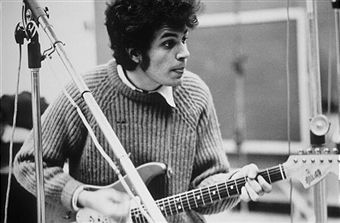
A years in the making documentary on the great blues guitarist Michael Bloomfield, “Sweet Blues: A Film About Michael Bloomfield,” will be premiered at the Mill Valley Film Festival in Mill Valley, CA, on October 11. Filmmaker Bob Sarles spent 25 years working on the documentary.
A taste of Bloomfield’s inimitable playing:
Bloomfield first came to national attention as a member of the Paul Butterfield Blues Band, a favorite of the counter-culture rock crowd
in the late ’60s. As a session guitarist he played on Bob Dylan’s album, Highway 61 Revisited, including Dylan’s Top 40 hit, “Like A Rolling Stone,” and was the lead guitarist in the band Dylan used at his infamous Newport Folk Festival performance, which was the first rock ‘n’ roll performance of Dylan’s professional career.
To introduce Bloomfield on November 15, 1980, when the guitarist joined Dylan for a performance of “Like A Rolling Stone” at the Warfield Theater in San Francisco, Dylan talked about meeting Bloomfield for the first time: “I was playing in a club in Chicago, I guess it was about 1956, or nineteen-sixty. And I was sittin’ there, I was sittin’ in a restaurant, I think it was, probably across the street, or maybe it was even part of the club, I’m not sure — but a guy came down and said that he played guitar. So he had his guitar with him, and he begin to play, I said, ‘Well what can you play?’ and he played all kinds of things, I don’t know if you’ve heard of a man, does Big Bill Broonzy ring a bell? Or, ah, Sonny Boy Williamson, that type of thing? He just played circles, around anything I could play, and I always remembered that.” (Thank you Greil Marcus, for including Dylan’s introduction in your book, “Like A Rolling Stone: Bob Dylan At The Crossroads”.)
So Dylan hired a great blues guitarist for the Highway 61 Revisited sessions, but he was intent on making his first full-bore rock album, so Dylan gave Bloomfield cryptic instructions before the sessions began.
“I went to his house first to hear the tunes,” Bloomfield said in a June 1968 interview for Hit Parader. “The first thing I heard was ‘Like a Rolling Stone.’ He wanted me to get the concept of it, how to play it. I figured he wanted blues, string bending, because that’s what I do. He said, ‘Hey, man, I don’t want any of that B. B. King stuff.’ So, OK, I really fell apart. What the heck does he want? We messed around with the song. I played the way that he dug and he said it was groovy.
“Then we went to the session,” Bloomfield continued. “Bob told me, ‘You talk to the musicians, man, I don’t want to tell them anything.’ So we get to the session. I didn’t know anything about it. All these studio cats are standing around. I come in like a dumb punk with my guitar over my back, no case, and I’m telling people about this and that, and this is the arrangement, and do this on the bridge. These are like the heaviest studio musicians in New York. They looked at me like I was crazy.”
Bloomfield and his band, The Electric Flag, at the Monterey Pop Festival in 1967:
Bloomfield’s biggest success came with the release of Super Session, a jam with Steven Stills and Al Kooper that reached #12 on the Billboard Top 200 in 1968, the year of its release.
Bloomfield is considered one rock’s greatest guitar players; he was ranked #22 in Rolling Stone’s “100 Greatest Guitarists Of All TIme.”
Bloomfield became addicted to heroin, and in the early ’70s, maintained a low profile, spending much of his time at his house in Mill Valley, CA. As a teenager, a friend and I knocked on Bloomfield’s front door one afternoon. He opened the door, and when we told him we were big fans, he invited us in. That day he spoke to us freely about the blues, as well as his sessions with Dylan. The following year when my friend and I were putting on dance concerts at Tam High in Mill Valley, Bloomfield agreed to play, and with a pickup band headlined the show at the high school auditorium and delivered what I remember as a knock-out performance.
For the rest of his life, Bloomfield played occasional club dates around the Bay Area, sometimes with the exceptional blues pianist Sunnyland Slim, including a terrific set I caught at the Opal Cliffs Inn in Santa Cruz. He was found dead of a drug overdose on February 15, 1981. He was 37 years old.
In the documentary, Sarles includes interviews with numerous people who knew Bloomfield including guitarist Carlos Santana, harmonica ace Charlie Musslewhite, singer/songwriter Country Joe McDonald, guitarist Elvin Bishop, B.B King, Al Kooper and many more.
Bluesman Charlie Musslewhite talks about Bloomfield in the film:
Concert promoter Bill Graham on Bloomfield: